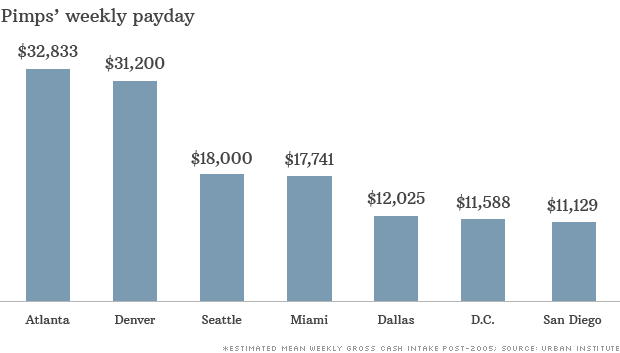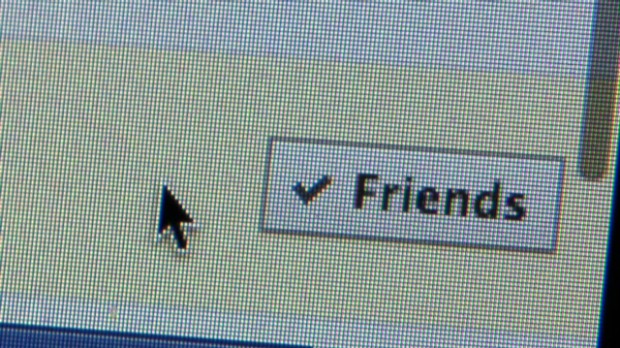
Inside the underground sex economy
By Jeanne Sahadi @CNNMoney March 12, 2014: 10:27 AM ET

NEW YORK (CNNMoney)
Until now there hasn't been a lot of data to help law enforcement and policymakers better understand the economics of the illegal sex trade and trafficking.
But a study released Wednesday by the Urban Institute's Justice Policy Center analyzes the size and structure of the underground commercial sex economies in eight major cities: San Diego, Seattle, Dallas, Denver, Washington, D.C., Miami, Atlanta and Kansas City, Missouri.
The three-year effort, which began in 2010, was funded by a $500,000 grant from the U.S. Department of Justice, which supports research that can aid in the prevention, detection and prosecution of human trafficking.
Researchers interviewed pimps, traffickers, sex workers and child pornography offenders, as well as local and federal law enforcement officers.
Of the eight cities studied, Atlanta had the largest cash-based underground sex economy at $290 million a year and Denver the smallest at $40 million, based on 2007 data. (There was insufficient data available for Kansas City, so it was dropped from the estimation analysis.)
The way in: Often pimps and prostitutes get into the business because they had a relative who worked in it or a friend who encouraged them. Neighborhood influence, poor job prospects and childhood trauma also played a role.
Coercion: It's often assumed that sex workers are physically coerced to work for and stay with a pimp. But researchers found that psychological manipulation played a major role, too -- whether it was the promise of attention from the pimp or more tangible incentives.
Likewise coercion through psychological or emotional abuse was used as a form of punishment to keep employees in line.
Related: Pimps hit social networks to recruit underage sex workers
The report recommends that states should include coercion -- not just physical but also the more subtle, non-physical forms -- in their definition of sex trafficking.
Gang involvement: Gangs are increasingly involved in prostitution and sex trafficking, especially in San Diego.
Often rival gangs will temporarily put aside their differences to work cooperatively to maximize their profits -- for instance, by sharing the same hotel out of which their prostitutes work.
Pimp circuits: Some pimps form networks across cities and regions, operating more as a brotherhood than as rivals. When transporting their sex workers to another city, their networks keep them apprised of law enforcement activities and offer advice on finding clients.

Pimps 'friend' victims on Facebook
Pimps interviewed also indicated that they thought pimping was a less risky crime than others, such as drug trafficking.
And many felt that "no one actually gets locked up for pimping," according to the report.
Role of the Internet: The cash-based sex trade has traditionally been street-based. But now the street is just one part of the trade, which has been greatly expanded by the online sex market. Participants told researchers they perceived the Internet to be less risky in terms of detection by law enforcement and it let them vet potential clients more easily.
Family, friends and legal businesses as facilitators: The underground sex economy is aided by above-board businesses. For example, a hotel's employees may look the other way when a pimp does business out of that hotel, and may even accept payment for doing so.
Meanwhile a pimp's friends or family may serve as drivers or security detail for his prostitutes.
No profit in child porn: Researchers found that there's an increasing amount of child pornography being produced in the United States, and it's increasingly graphic and violent.
But it's often available for free and offenders interviewed said they were part of online child pornography communities.
"Why pay?" one respondent told researchers. "I guess I just assumed that anyone asking for money was a sting."
Those incarcerated for non-contact child porn offenses -- such as possession and distribution -- said they consider it a victimless crime since they weren't producing the pornography.
Offenders did, however, indicate that they want treatment but said there are few options for it in prison.
Among the report's recommendations: Laws should hold criminally responsible anyone who facilitates or hosts online child pornography content and communities.
© 2014 Cable News Network. A Time Warner Company. All Rights Reserved. Terms under which this service is provided to you. Privacy Policy. AdChoices .
.



NEW YORK (CNNMoney)
Until now there hasn't been a lot of data to help law enforcement and policymakers better understand the economics of the illegal sex trade and trafficking.
But a study released Wednesday by the Urban Institute's Justice Policy Center analyzes the size and structure of the underground commercial sex economies in eight major cities: San Diego, Seattle, Dallas, Denver, Washington, D.C., Miami, Atlanta and Kansas City, Missouri.
The three-year effort, which began in 2010, was funded by a $500,000 grant from the U.S. Department of Justice, which supports research that can aid in the prevention, detection and prosecution of human trafficking.
Researchers interviewed pimps, traffickers, sex workers and child pornography offenders, as well as local and federal law enforcement officers.
Of the eight cities studied, Atlanta had the largest cash-based underground sex economy at $290 million a year and Denver the smallest at $40 million, based on 2007 data. (There was insufficient data available for Kansas City, so it was dropped from the estimation analysis.)
The way in: Often pimps and prostitutes get into the business because they had a relative who worked in it or a friend who encouraged them. Neighborhood influence, poor job prospects and childhood trauma also played a role.
Coercion: It's often assumed that sex workers are physically coerced to work for and stay with a pimp. But researchers found that psychological manipulation played a major role, too -- whether it was the promise of attention from the pimp or more tangible incentives.
Likewise coercion through psychological or emotional abuse was used as a form of punishment to keep employees in line.
Related: Pimps hit social networks to recruit underage sex workers
The report recommends that states should include coercion -- not just physical but also the more subtle, non-physical forms -- in their definition of sex trafficking.
Gang involvement: Gangs are increasingly involved in prostitution and sex trafficking, especially in San Diego.
Often rival gangs will temporarily put aside their differences to work cooperatively to maximize their profits -- for instance, by sharing the same hotel out of which their prostitutes work.
Pimp circuits: Some pimps form networks across cities and regions, operating more as a brotherhood than as rivals. When transporting their sex workers to another city, their networks keep them apprised of law enforcement activities and offer advice on finding clients.

Pimps 'friend' victims on Facebook
Pimps interviewed also indicated that they thought pimping was a less risky crime than others, such as drug trafficking.
And many felt that "no one actually gets locked up for pimping," according to the report.
Role of the Internet: The cash-based sex trade has traditionally been street-based. But now the street is just one part of the trade, which has been greatly expanded by the online sex market. Participants told researchers they perceived the Internet to be less risky in terms of detection by law enforcement and it let them vet potential clients more easily.
Family, friends and legal businesses as facilitators: The underground sex economy is aided by above-board businesses. For example, a hotel's employees may look the other way when a pimp does business out of that hotel, and may even accept payment for doing so.
Meanwhile a pimp's friends or family may serve as drivers or security detail for his prostitutes.
No profit in child porn: Researchers found that there's an increasing amount of child pornography being produced in the United States, and it's increasingly graphic and violent.
But it's often available for free and offenders interviewed said they were part of online child pornography communities.
"Why pay?" one respondent told researchers. "I guess I just assumed that anyone asking for money was a sting."
Those incarcerated for non-contact child porn offenses -- such as possession and distribution -- said they consider it a victimless crime since they weren't producing the pornography.
Offenders did, however, indicate that they want treatment but said there are few options for it in prison.
Among the report's recommendations: Laws should hold criminally responsible anyone who facilitates or hosts online child pornography content and communities.

© 2014 Cable News Network. A Time Warner Company. All Rights Reserved. Terms under which this service is provided to you. Privacy Policy. AdChoices
 .
.


No comments:
Post a Comment